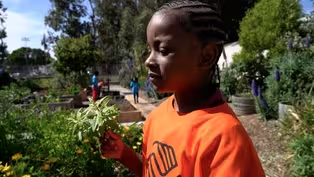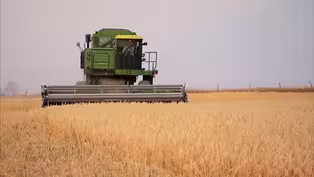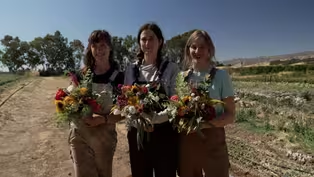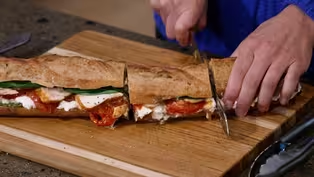
Microgreens - Harvesting Health
Clip: 9/20/2024 | 4m 30sVideo has Closed Captions
Our nutrition expert takes a closer look at microgreens.
Harvesting Health host Dr. Daphne Miller takes a closer look at microgreens, and why this "tiny but mighty" crop packs a big nutritional punch. Microgreens can be grown on a windowsill or in a pot, making it a great choice for home gardeners.
Problems playing video? | Closed Captioning Feedback
Problems playing video? | Closed Captioning Feedback
America's Heartland is presented by your local public television station.
Funding for America’s Heartland is provided by US Soy, Sustainable Agriculture Research and Education, Rural Development Partners, and a Specialty Crop Grant from the California Department of Food and Agriculture.

Microgreens - Harvesting Health
Clip: 9/20/2024 | 4m 30sVideo has Closed Captions
Harvesting Health host Dr. Daphne Miller takes a closer look at microgreens, and why this "tiny but mighty" crop packs a big nutritional punch. Microgreens can be grown on a windowsill or in a pot, making it a great choice for home gardeners.
Problems playing video? | Closed Captioning Feedback
How to Watch America's Heartland
America's Heartland is available to stream on pbs.org and the free PBS App, available on iPhone, Apple TV, Android TV, Android smartphones, Amazon Fire TV, Amazon Fire Tablet, Roku, Samsung Smart TV, and Vizio.
Providing Support for PBS.org
Learn Moreabout PBS online sponsorship- So here we are at Dragon Spunk Farm, a tiny farm in the Bayview-Hunters Point of San Francisco.
It's tucked between the freeways and it's this little garden of Eden.
And it's appropriate in such a tiny farm to be talking about a tiny vegetable.
I am here to talk about micro greens today that they're growing here at Dragon Spunk Farms.
Micro greens, they're kind of bigger than a sprout, but smaller than a baby green.
And they come in these gorgeous colors.
Right here we have a rainbow radish micro green, and they are beloved by chefs because you can sprinkle some of them on top of a sculpted appetizer, and they're beautiful and they also give you a nice, strong flavor.
But my question was, for those of us who are not eating in fancy restaurants, do these things hold any nutritional value?
Are they just kind of pretty garnishes?
And as I did my research, I found out that we actually can get so much nutrition from these tiny greens.
They punch way above their size as vegetables.
And they're basically micro vegetables that have been harvested long before they grow into the big vegetable.
And you can use the regular seed that you use to grow the big vegetable, but just harvest it early.
And what happens is that that seed pumps all of its nutrients into that early, early set of leaves in order to protect them and make them grow.
And you benefit from all that when you eat these early.
And that's why micro greens tend to have five to 10 times the nutrients of the big daddy vegetable.
It turns out that these greens are really rich in vitamin C and vitamin A and vitamin E and all those powerful carotenoids and phytochemicals, which are important in protecting us from cancer and heart disease and in lowering our cholesterol and in fighting diabetes and neurodegenerative diseases.
So folks grow micro greens indoors on a window sill.
They can grow outside on a window pot.
They can grow on your deck, or they can certainly grow directly in the soil, in your garden.
So my favorite way to eat micro greens is to put them in or on an omelet or to actually make a salad of them or put them in my favorite sandwich.
And I've also been known to sprinkle them on my desserts.
And how many days on average do you let your greens grow to?
- If I'm under commercial pressure a week and a half, two weeks.
Now, certain crops like your basil, it's a short crop naturally, right?
It's very short.
So I give that 20 days, 21 days before it reaches a height that's easy for me to harvest.
- And how about for the home growers?
'cause we are hoping that people get inspired by you and use this as a way to get free vegetables on their deck or their window sill or their kitchen counter.
How many days should they wait in general?
- I would say seven days.
But you know, don't use a number, observe a lot.
Anytime you're dealing with cultivation, it's observation.
You have to develop a relationship.
You wanna look at this thing every single day, and you can determine when you want to eat it based on how it looks to you.
- What is the best sell you can give as a micro green grower to get them to at least try their first bite?
- I am going to introduce you to flavor 'cause you haven't had it before.
You've been using Lowry's or McCormick's and all that.
Imagine using no seasoning and using micro greens as your flavor.
- Thank you for joining me today at Dragon Spunk Farm, where we learned how tiny vegetables can be mighty medicine.
Video has Closed Captions
Clip: 9/20/2024 | 5m 7s | A farm in San Francisco inspires people living in urban neighborhoods to grow their own food. (5m 7s)
Video has Closed Captions
Clip: 9/20/2024 | 3m 9s | Visit a farm in Montana growing a specialty oat that’s used in gluten-free products. (3m 9s)
Video has Closed Captions
Clip: 9/20/2024 | 5m 21s | Meet a husband-and-wife team growing and selling organic flowers. (5m 21s)
Roasted Tomato Sandwich - Farm to Fork with Sharon Profis
Video has Closed Captions
Clip: 9/20/2024 | 5m 9s | Learn how to make chicken sandwiches with fresh pesto, burrata cheese and fresh roasted tomatoes. (5m 9s)
Providing Support for PBS.org
Learn Moreabout PBS online sponsorship
- Food
Lidia Celebrates America
Lidia Bastianich honors America’s volunteers, revealing how giving back unites and uplifts.













Support for PBS provided by:
America's Heartland is presented by your local public television station.
Funding for America’s Heartland is provided by US Soy, Sustainable Agriculture Research and Education, Rural Development Partners, and a Specialty Crop Grant from the California Department of Food and Agriculture.




